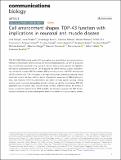Cell environment shapes TDP-43 function with implications in neuronal and muscle disease
Author(s)
Fraenkel, Ernest
DownloadPublished version (2.119Mb)
Publisher with Creative Commons License
Publisher with Creative Commons License
Creative Commons Attribution
Terms of use
Metadata
Show full item recordAbstract
<jats:title>Abstract</jats:title><jats:p>TDP-43 (TAR DNA-binding protein 43) aggregation and redistribution are recognised as a hallmark of amyotrophic lateral sclerosis and frontotemporal dementia. As TDP-43 inclusions have recently been described in the muscle of inclusion body myositis patients, this highlights the need to understand the role of TDP-43 beyond the central nervous system. Using RNA-seq, we directly compare TDP-43-mediated RNA processing in muscle (C2C12) and neuronal (NSC34) mouse cells. TDP-43 displays a cell-type-characteristic behaviour targeting unique transcripts in each cell-type, which is due to characteristic expression of RNA-binding proteins, that influence TDP-43’s performance and define cell-type specific splicing. Among splicing events commonly dysregulated in both cell lines, we identify some that are TDP-43-dependent also in human cells. Inclusion levels of these alternative exons are altered in tissues of patients suffering from FTLD and IBM. We therefore propose that TDP-43 dysfunction contributes to disease development either in a common or a tissue-specific manner.</jats:p>
Date issued
2022Department
Massachusetts Institute of Technology. Department of Biological EngineeringJournal
Communications Biology
Publisher
Springer Science and Business Media LLC
Citation
Fraenkel, Ernest. 2022. "Cell environment shapes TDP-43 function with implications in neuronal and muscle disease." Communications Biology, 5 (1).
Version: Final published version